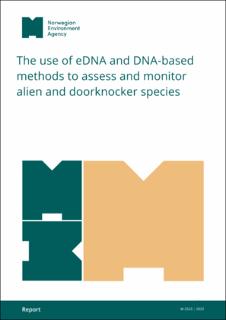The use of eDNA and DNA based methods to assess and monitor alien and doorknocker species
Ekrem, Torbjørn; Baussant, Thierry; Dunshea, Glenn John; Dunthorn, Micah; Egge, Elianne Dunthorn; Engesmo, Anette; Fossøy, Frode; Hansen, Haakon; Kistenich, Sonja; Krolicka, Adriana; Larsen, Aud; Mauvisseau, Quentin; Strand, David; Vrålstad, Trude; Westergaard, Kristine Bakke
Research report
Published version

Permanent lenke
https://hdl.handle.net/11250/3064927Utgivelsesdato
2023Metadata
Vis full innførselSamlinger
- Institutt for naturhistorie [1245]
- Publikasjoner fra CRIStin - NTNU [38679]
Sammendrag
All organisms leave traces of their DNA in the environment they live in. This environmental DNA (eDNA) can be used to detect and monitor single species as well as communities, and potentially be utilized in early warning systems to detect alien species. In this report, we give an overview of eDNA-based methods used to detect and monitor alien species, and give examples of speciesspecific assays designed to identify species that are alien to Norwegian nature or have the potential to establish viable populations in Norway (doorknockers). We emphasize the need for several stages of testing before species-specific assays can be operational, and discuss the importance of including models to assess detection probabilities. Going through standards for sampling and analyses, we suggest a number of minimum requirements for eDNA sampling, laboratory practice, bioinformatics and the use of reference libraries, as well as for reporting results from eDNA studies. The origin and fate of eDNA in different environments can influence its usefulness in detecting and monitoring alien species. We outline factors for terrestrial, freshwater and marine ecosystems and provide examples from six case studies where eDNA has been used to detect and/or monitor alien invasive species: invertebrates and vascular plants in soil of imported ornamental plants, freshwater crayfish and crayfish plague, Gyrodactylus salaris, pink salmon, Canadian pondweed, and American lobster. We provide a decision diagram for detection and monitoring of invasive species starting with early considerations for implementation of a monitoring program, and ending with management decision points depending on detection outcomes at different stages. Finally, we provide some key recommendations for the use of eDNA in assessments of alien and doorknocker species. Bruk av miljø-DNA og DNA-baserte metoder for å vurdere og overvåke fremmede arter og dørstokkarter. The use of eDNA and DNA-based methods to assess and monitor alien and doorknocker species